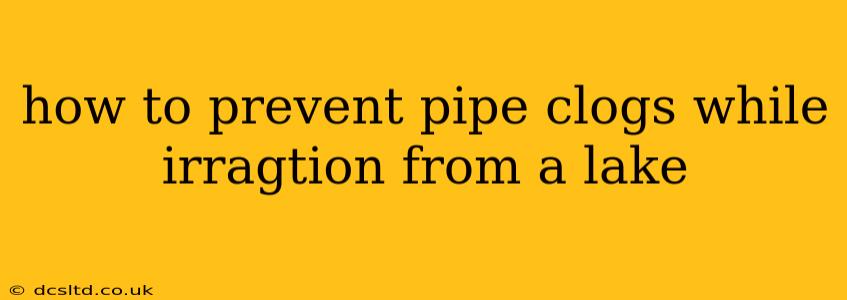Irrigating your land from a lake offers a sustainable water source, but it comes with the unique challenge of preventing pipe clogs. Lake water often contains sediment, algae, aquatic plants, and other debris that can easily accumulate in your irrigation system, leading to reduced water flow, pressure loss, and costly repairs. This comprehensive guide will equip you with the strategies to minimize clogs and maintain a smooth, efficient irrigation system.
What Causes Pipe Clogs in Lake Irrigation Systems?
Before diving into prevention, understanding the culprits is crucial. The most common causes of pipe clogs in lake irrigation systems include:
- Sediment: Fine particles of sand, silt, and clay carried by the water.
- Algae: Rapidly growing algae can form thick mats that restrict water flow.
- Aquatic Plants: Fragments of weeds, grasses, and other aquatic vegetation.
- Insects and Other Organisms: Small creatures that can accumulate in pipes.
- Minerals and Chemicals: Dissolved minerals and chemicals in the lake water can precipitate and clog pipes over time.
How to Prevent Pipe Clogs in Your Lake Irrigation System
Implementing a multi-pronged approach is key to effective clog prevention. Here are some essential strategies:
1. Proper Intake and Filtration:
- Submersible Intake: Position your lake water intake pipe several feet below the water's surface to minimize the intake of surface debris and floating plants.
- Screen Filters: Install a coarse screen filter at the intake point to remove larger debris like leaves, twigs, and larger aquatic plants. Consider using multiple stages of filtration for best results.
- Sand Filters: These are highly effective at removing fine sediment and sand particles. Regular backwashing or cleaning is vital.
- Membrane Filters: For the most effective filtration, consider using a membrane filter. This removes even the smallest particles, but requires more maintenance and may be more expensive.
2. Regular Maintenance and Cleaning:
- Flush the System: Regularly flush your irrigation lines to remove accumulated sediment. This is especially important after periods of inactivity.
- Inspect and Clean Filters: Regularly inspect and clean or replace your filters according to the manufacturer's recommendations. Frequency depends on water quality and system usage.
- Inspect Pipes: Periodically inspect your pipes for signs of clogging or damage.
3. System Design and Materials:
- Pipe Size and Material: Use appropriately sized pipes with smooth interior surfaces to minimize friction and reduce the likelihood of clogs. Consider using materials resistant to corrosion and algae growth, such as high-density polyethylene (HDPE) pipes.
- Pipe Slope and Layout: Ensure proper pipe slope to facilitate efficient water flow and reduce sediment settling. Avoid sharp bends that could trap debris.
4. Water Treatment (If Necessary):
- Chemical Treatment: In extreme cases, a chemical treatment might be necessary to control algae growth or to break down mineral deposits. However, it's crucial to choose a treatment that is safe for the environment and your irrigation system.
- UV Sterilization: Ultraviolet (UV) sterilization can effectively kill algae and other microorganisms, minimizing their contribution to clogs.
5. Monitoring and Response
- Pressure Gauges: Install pressure gauges at key points in your system to monitor pressure changes. Significant drops in pressure might indicate a developing clog.
- Flow Meters: Flow meters can detect reductions in water flow, another indicator of a potential clog.
- Regular System Checks: Develop a routine for regular checks, including filter inspections, pressure monitoring, and visual checks of pipes.
What if I already have a clog?
If you've already identified a clog, try these steps:
- Flush the Line: Attempt to flush the line with high-pressure water.
- Chemical Cleaning: Carefully consider using a commercial pipe cleaning solution. Always follow the manufacturer's instructions.
- Mechanical Cleaning: In extreme cases, you may need to mechanically clear the clog using specialized tools.
Frequently Asked Questions (FAQ)
Q: What type of filter is best for lake irrigation?
A: The best filter depends on the specific water quality of your lake. A multi-stage approach, combining coarse screens, sand filters, and possibly membrane filters, often provides the most effective solution.
Q: How often should I flush my irrigation lines?
A: The frequency depends on water quality and system usage. As a general guideline, flushing at least once a month, or more frequently during periods of high algae growth or sediment, is advisable.
Q: Can I use city water to flush my irrigation lines?
A: Yes, city water can be used for flushing, but ensure that you use a sufficient amount of water to fully clear the lines.
Q: How can I tell if my irrigation system has a clog?
A: Look for reduced water flow, low pressure at the sprinklers, uneven watering, and unusual sounds coming from your pipes.
By carefully implementing these strategies, you can significantly reduce the chances of pipe clogs in your lake irrigation system and ensure years of reliable and efficient operation. Remember that regular maintenance and proactive measures are your best allies in preventing costly repairs and disruptions.
